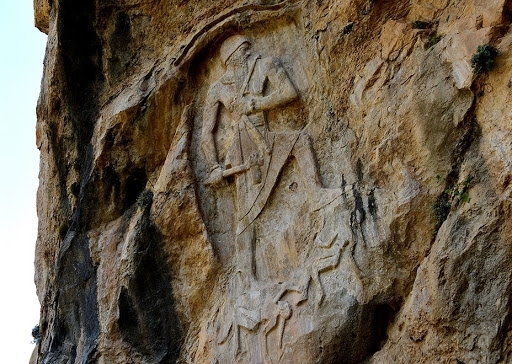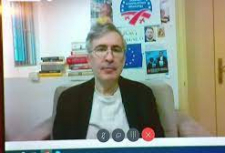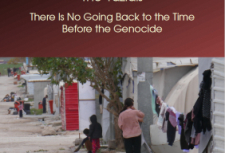Mesopotamian heirs living in Georgia

Excerpt from the article "Know each other better"
There is not a single country in the world where people of different nationalities do not live. Georgia is no exception, where Jews, Greeks, and Armenians lived in the pre-Christian period for 26 centuries, and the Jewish community in Georgia. And even one of the" youngest " German communities in terms of resettlement recently celebrated the 190th anniversary of moving from the land of Württemberg to Georgia. The contribution of representatives of various diasporas to the development of politics, economy, science, and culture of their own historical homelands is great.
Yazidis
The Yazidis are the oldest inhabitants of the East. Their historical cradle is Upper Mesopotamia. The history of the Yazidis and Yazidism, one of the oldest religions in the world, dates back more than five thousand years. This religion dates to the times of Sumer, Babylon, and Assyria. The Yazidi religion has had a significant impact on the foundations of the religious teachings of Mazdeism and Zoroastrianism. Despite its ancient origin, Yazidism is a monotheistic religion, that is, it preaches monotheism. The Yazidis worship the Supreme God (Xwede) and his triad. In the understanding of the Yazidis, as well as in the understanding of Jews, Christians, and Muslims, God is the creator and patron of the world, of all things. From the Most High comes all good and evil. The religious ideas of the Yazidis about the transmigration of souls completely coincide with the ideas existing in other world religions. It is noteworthy that Yazidism as a creed is almost completely preserved to this day. Yazidis have a common opinion about the deity and the meaning of the word "Yazid" ("ezdi"). According to their ideas, it means "God", and the Yazidis themselves are created by God and followers of God. Since ancient times, there have been Yazidi religious books. The Yazidi alphabet consisted of 35 letters. Unfortunately, the Yazidi alphabet itself and almost all religious books were destroyed by the persecutors of the Yazidi religion. At present, we can only speak of two sacred religious books, the Keteba Jelva ("Book of Revelation") and " Maskhafa Rashi "("Black Chronicle"), which are in the holy temple of the Yazidis" Lalesh", located in the mountains of Sinjar (Northern Kurdistan), the territory of modern Iraq. These books became famous thanks to the English missionary O. Perry. They were soon translated into Chaldean, Assyrian, Arabic, Greek, Latin, etc. languages. Lalesh is the holy place of all Yezidis. It is a temple of the Yazidi religion. The entrance to it is guarded by a stone statue of a snake. In October, the main religious holiday "Aida Shih Adi" ("Sheikh Adi Holiday") is celebrated. The Yazidis have been persecuted throughout their history. They were forcibly assimilated, forced to turn away from their faith. The process of persecution and physical extermination of Yazidis can be divided into several stages. The first phase begins in the seventh century with the rise of Islam and the advance of the Arabs into Mesopotamia with the aim of instilling a new faith there. It was during this period that a significant part of the followers of the Yazidi faith, under the guise of Zoroastrianism, together with the Zoroastrians, left their original places of residence and fled to Iran and India to relatively safe places. The second stage of the persecution of the Yazidis falls in the late Middle Ages, and the third and fourth in the new and modern periods. The fate of the Yazidis is very peculiar and tragic.
Most of them were forced to abandon the faith of their ancestors and convert to Islam to survive. This fact can be considered one of the reasons for the decline in the number of Yazidis. Large tribal associations of the Yazidis refused to accept other religions, that is, their adoption, and defended the religion of their ancestors with weapons in their hands. Russian-Iranian, Russian-Turkish, and Crimean wars resulted in a small number of Yezidis becoming subjects of the Russian Empire, particularly in Armenia and Georgia. In Georgia, several tens of thousands of Yazidis live compactly in the cities of Tbilisi, Telavi, Rustavi, as well as in Adjara. Before the collapse of the USSR, Georgia paid great attention to socio-economic and cultural and educational issues. So, in the 20s, a boarding school for orphans was opened; "educational programs" committees for the elimination of illiteracy were created; nine-month teacher courses were opened; the so-called "Kurdish Club" (The Yazidis of Georgia in the USSR were called Kurds, in view of political gain). Two primary and one seven-year national schools were established by the Government; a section of Kurdish writers was established under the Georgian Writers Union; and folk song and dance ensembles were established; there was a national theater, later called the People's Theater, which was the only theater of the Yazidis in the entire territory of the former USSR. A national program was broadcast on Georgian radio, clubs were opened for the study of the native language and literature; representatives of this nationality held positions in the state administration bodies they were members of the government and Parliament. The population was closely integrated in the general republican life and considered themselves full citizens of Georgia on an equal basis with other national minorities. Unfortunately, that was all in the past. Since the beginning of the 1990s, the social, cultural, and legal situation of the Yazidis has deteriorated dramatically. For some reason, the above-mentioned cultural groups have ceased to function. Despite the efforts of the public and the weak support of some government figures, it is impossible to restore the past in the field of culture. Due to the lack of a basis for the study and preservation of Yazidism, the Yazidi diaspora and the clergy are not able to spread the dogmas and teachings of a unique monotheistic religion among young people and the population.
Azize Isko (Sloev)
Born in Tbilisi. Teacher educator with 50 years of teaching experience. Honored Teacher of Georgia. Member of the Union of Writers of the USSR. Recipient of the Order of Honor and Medals. He was repeatedly elected as a deputy of the district and Tbilisi City Council of People's Deputies. A prominent public figure. Personal pensioner of national significance. For the last 15 years, he worked in the laboratory of the Tbilisi Institute for the Improvement of Teachers of Methodologists of Oriental Languages. He died on January 6, 2005 in Yaroslavl (Russia). He was buried in Tbilisi.
Lamara Pashayeva
The name of this man is known throughout the Yazidi community of Georgia and far beyond its borders. Speaking of Lamara Borisovna Pashayeva, it is often necessary to use the definition of the first. She is the world's first Yazidi candidate of historical Sciences. The author of about 40 scientific papers, monographs, articles about the Greeks and Kurds, in fact, one of the founders of Georgian Kurdish studies. Senior researcher of the Institute of History and Ethnology traveled with scientific expeditions all over Georgia, worked annually in the archives of the departments of Kurdish studies of the Institutes of Oriental Studies of Leningrad and Yerevan, studied the settlements, settlement of Kurds and Yezidis in Georgia, their wedding customs and rituals, music, and songs. The scientist has been interested in her roots since childhood, because the Pashayev family is from Turkish Kurdistan, where her grandfather had a large prosperous farm, herds of sheep and cattle in the village of Kalajykh, near Lake Van. The genocide during the First World War forced tens of thousands of Yazidis to leave their homes and move to Transcaucasia. So, the Lamara family came to Tbilisi in 1918. L. Pashayeva successfully graduated from high school and entered the Faculty of Oriental Studies of TSU, where she specialized in the Turkish language and the history of the Middle East. The graduate of the Russian school at first found Georgian harder than Turkish, but by the end of the university she had mastered the state language of the republic. In 1965, Lamara Pashayeva entered graduate school, five years later she defended her dissertation on the topic Family and family life of the Urums of the Tsalki district. Among the innovations of the work was the establishment of the ethnic origin of some Urum (Turkic-speaking) families of Tat, Kurdish, and Jewish. In the villages of the Tsalki district, she had the opportunity to speak with local residents in their native language. For many years, a researcher at the Institute of History and Ethnology worked on the problems of the Greeks and Kurds living in Akhaltsikhe, Tetri Tskaro, Adjara and Abkhazia. Since 1985, the main topic of her research has been Kurdish studies, she has participated in numerous conferences on this topic in Russia, Armenia, and Georgia, and has contributed to the restoration of historical Yazidi, Assyrian, and Greek surnames through the Ministry of Justice of Georgia. Tbilisi has become the birthplace of many famous Kurdish scholars. It is enough to mention the names of Academician Ivan Farizog from the Institute of World Economy, Professor Kanat Kurdoev from the Institute of Oriental Studies, Doctors of Philology Cherkes Bakayev and Zara Yusupova. And in Tbilisi, Doctor of Historical Sciences Albert Menteshashvili, Vice-rector of the Institute of Asia and Africa Kerim Amoev. And in this worthy row, the name of Lamara Pashayeva was not lost. Lamara Borisovna is not only a prominent scientist, but also an active public figure.
docplayer.ru
Tags: #yazidisinfo #newsyazidi #ezidi #mesopotamia
Mesopotamian heirs living in Georgia

Excerpt from the article "Know each other better"
There is not a single country in the world where people of different nationalities do not live. Georgia is no exception, where Jews, Greeks, and Armenians lived in the pre-Christian period for 26 centuries, and the Jewish community in Georgia. And even one of the" youngest " German communities in terms of resettlement recently celebrated the 190th anniversary of moving from the land of Württemberg to Georgia. The contribution of representatives of various diasporas to the development of politics, economy, science, and culture of their own historical homelands is great.
Yazidis
The Yazidis are the oldest inhabitants of the East. Their historical cradle is Upper Mesopotamia. The history of the Yazidis and Yazidism, one of the oldest religions in the world, dates back more than five thousand years. This religion dates to the times of Sumer, Babylon, and Assyria. The Yazidi religion has had a significant impact on the foundations of the religious teachings of Mazdeism and Zoroastrianism. Despite its ancient origin, Yazidism is a monotheistic religion, that is, it preaches monotheism. The Yazidis worship the Supreme God (Xwede) and his triad. In the understanding of the Yazidis, as well as in the understanding of Jews, Christians, and Muslims, God is the creator and patron of the world, of all things. From the Most High comes all good and evil. The religious ideas of the Yazidis about the transmigration of souls completely coincide with the ideas existing in other world religions. It is noteworthy that Yazidism as a creed is almost completely preserved to this day. Yazidis have a common opinion about the deity and the meaning of the word "Yazid" ("ezdi"). According to their ideas, it means "God", and the Yazidis themselves are created by God and followers of God. Since ancient times, there have been Yazidi religious books. The Yazidi alphabet consisted of 35 letters. Unfortunately, the Yazidi alphabet itself and almost all religious books were destroyed by the persecutors of the Yazidi religion. At present, we can only speak of two sacred religious books, the Keteba Jelva ("Book of Revelation") and " Maskhafa Rashi "("Black Chronicle"), which are in the holy temple of the Yazidis" Lalesh", located in the mountains of Sinjar (Northern Kurdistan), the territory of modern Iraq. These books became famous thanks to the English missionary O. Perry. They were soon translated into Chaldean, Assyrian, Arabic, Greek, Latin, etc. languages. Lalesh is the holy place of all Yezidis. It is a temple of the Yazidi religion. The entrance to it is guarded by a stone statue of a snake. In October, the main religious holiday "Aida Shih Adi" ("Sheikh Adi Holiday") is celebrated. The Yazidis have been persecuted throughout their history. They were forcibly assimilated, forced to turn away from their faith. The process of persecution and physical extermination of Yazidis can be divided into several stages. The first phase begins in the seventh century with the rise of Islam and the advance of the Arabs into Mesopotamia with the aim of instilling a new faith there. It was during this period that a significant part of the followers of the Yazidi faith, under the guise of Zoroastrianism, together with the Zoroastrians, left their original places of residence and fled to Iran and India to relatively safe places. The second stage of the persecution of the Yazidis falls in the late Middle Ages, and the third and fourth in the new and modern periods. The fate of the Yazidis is very peculiar and tragic.
Most of them were forced to abandon the faith of their ancestors and convert to Islam to survive. This fact can be considered one of the reasons for the decline in the number of Yazidis. Large tribal associations of the Yazidis refused to accept other religions, that is, their adoption, and defended the religion of their ancestors with weapons in their hands. Russian-Iranian, Russian-Turkish, and Crimean wars resulted in a small number of Yezidis becoming subjects of the Russian Empire, particularly in Armenia and Georgia. In Georgia, several tens of thousands of Yazidis live compactly in the cities of Tbilisi, Telavi, Rustavi, as well as in Adjara. Before the collapse of the USSR, Georgia paid great attention to socio-economic and cultural and educational issues. So, in the 20s, a boarding school for orphans was opened; "educational programs" committees for the elimination of illiteracy were created; nine-month teacher courses were opened; the so-called "Kurdish Club" (The Yazidis of Georgia in the USSR were called Kurds, in view of political gain). Two primary and one seven-year national schools were established by the Government; a section of Kurdish writers was established under the Georgian Writers Union; and folk song and dance ensembles were established; there was a national theater, later called the People's Theater, which was the only theater of the Yazidis in the entire territory of the former USSR. A national program was broadcast on Georgian radio, clubs were opened for the study of the native language and literature; representatives of this nationality held positions in the state administration bodies they were members of the government and Parliament. The population was closely integrated in the general republican life and considered themselves full citizens of Georgia on an equal basis with other national minorities. Unfortunately, that was all in the past. Since the beginning of the 1990s, the social, cultural, and legal situation of the Yazidis has deteriorated dramatically. For some reason, the above-mentioned cultural groups have ceased to function. Despite the efforts of the public and the weak support of some government figures, it is impossible to restore the past in the field of culture. Due to the lack of a basis for the study and preservation of Yazidism, the Yazidi diaspora and the clergy are not able to spread the dogmas and teachings of a unique monotheistic religion among young people and the population.
Azize Isko (Sloev)
Born in Tbilisi. Teacher educator with 50 years of teaching experience. Honored Teacher of Georgia. Member of the Union of Writers of the USSR. Recipient of the Order of Honor and Medals. He was repeatedly elected as a deputy of the district and Tbilisi City Council of People's Deputies. A prominent public figure. Personal pensioner of national significance. For the last 15 years, he worked in the laboratory of the Tbilisi Institute for the Improvement of Teachers of Methodologists of Oriental Languages. He died on January 6, 2005 in Yaroslavl (Russia). He was buried in Tbilisi.
Lamara Pashayeva
The name of this man is known throughout the Yazidi community of Georgia and far beyond its borders. Speaking of Lamara Borisovna Pashayeva, it is often necessary to use the definition of the first. She is the world's first Yazidi candidate of historical Sciences. The author of about 40 scientific papers, monographs, articles about the Greeks and Kurds, in fact, one of the founders of Georgian Kurdish studies. Senior researcher of the Institute of History and Ethnology traveled with scientific expeditions all over Georgia, worked annually in the archives of the departments of Kurdish studies of the Institutes of Oriental Studies of Leningrad and Yerevan, studied the settlements, settlement of Kurds and Yezidis in Georgia, their wedding customs and rituals, music, and songs. The scientist has been interested in her roots since childhood, because the Pashayev family is from Turkish Kurdistan, where her grandfather had a large prosperous farm, herds of sheep and cattle in the village of Kalajykh, near Lake Van. The genocide during the First World War forced tens of thousands of Yazidis to leave their homes and move to Transcaucasia. So, the Lamara family came to Tbilisi in 1918. L. Pashayeva successfully graduated from high school and entered the Faculty of Oriental Studies of TSU, where she specialized in the Turkish language and the history of the Middle East. The graduate of the Russian school at first found Georgian harder than Turkish, but by the end of the university she had mastered the state language of the republic. In 1965, Lamara Pashayeva entered graduate school, five years later she defended her dissertation on the topic Family and family life of the Urums of the Tsalki district. Among the innovations of the work was the establishment of the ethnic origin of some Urum (Turkic-speaking) families of Tat, Kurdish, and Jewish. In the villages of the Tsalki district, she had the opportunity to speak with local residents in their native language. For many years, a researcher at the Institute of History and Ethnology worked on the problems of the Greeks and Kurds living in Akhaltsikhe, Tetri Tskaro, Adjara and Abkhazia. Since 1985, the main topic of her research has been Kurdish studies, she has participated in numerous conferences on this topic in Russia, Armenia, and Georgia, and has contributed to the restoration of historical Yazidi, Assyrian, and Greek surnames through the Ministry of Justice of Georgia. Tbilisi has become the birthplace of many famous Kurdish scholars. It is enough to mention the names of Academician Ivan Farizog from the Institute of World Economy, Professor Kanat Kurdoev from the Institute of Oriental Studies, Doctors of Philology Cherkes Bakayev and Zara Yusupova. And in Tbilisi, Doctor of Historical Sciences Albert Menteshashvili, Vice-rector of the Institute of Asia and Africa Kerim Amoev. And in this worthy row, the name of Lamara Pashayeva was not lost. Lamara Borisovna is not only a prominent scientist, but also an active public figure.
docplayer.ru
Tags: #yazidisinfo #newsyazidi #ezidi #mesopotamia


























